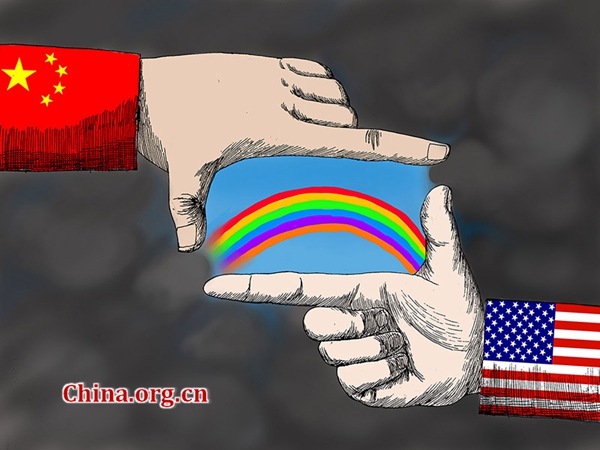Forty-five years of China-US relationship
- By Zhang Zhixin
 0 Comment(s)
0 Comment(s) Print
Print E-mail China.org.cn, March 19, 2017
E-mail China.org.cn, March 19, 2017
|
|
|
China-US relations [By Zhang Xueshi / China.org.cn] |
On Feb. 28, 1972, China and the United States released the Shanghai Communiqué, which laid out the foundation for the two countries to establish diplomatic ties.
The Shanghai Communiqué is a highly creative and significant guiding document for this relationship. The architect of this on the U.S. side, President Richard Nixon, described it as "a bridge across 16,000 miles and 22 years of hostilities dividing us in the past." It still has a profound guiding significance for the countries' current relationship.
President Nixon was willing to break the ice by visiting China, highlighting that easing tensions between China and the U.S. conformed with changes in the international situation and was beneficial to the national interests of both sides.
In the late 1960s and early 1970s, sunk deep in the mire of the Vietnam War, the United States was at a strategic disadvantage while competing for world hegemony with the Soviet Union. At the same time, its blockade and isolation policies towards China hadn't worked. Increasingly, it couldn't ignore China's existence in the international community.
The great foresight and strategic determination of the leaders of the two countries become a decisive factor in improving the climate for the issuance of the Shanghai Communiqué.
The strategic initiative of "building a new model of major country relations" put forward by new leaders on both sides in 2012 was also a result of progressive advances on the previous basis of "building a positive, cooperative and comprehensive bilateral relationship." Thus, it's clear there is no other option but to cooperation.
Second, in long-term contacts, the two countries have always sought common ground while holding back differences to form a situation where competition and cooperation coexist. One-sided emphasis on differences and competition between the two sides may entail dreadful consequences, such as strategic conflicts.
Obviously, it is very difficult for China and the United States to reach a consensus on every issue due to different historical and cultural backgrounds and different political systems. However, the Shanghai Communiqué tells us that seeking common ground while holding back differences is a "magic weapon" to maintain a stable development of relations.
For example, although countries around the world cannot reach a consensus on the definition of terrorism, it does not prevent China and the U.S. from jointly dealing with it.
Since the end of the Cold War, every U.S. president has been inclined to adopt tough policies towards China early in their time in office. However, relations have always come back on track after a "learning curve" period by the new administration. The reason is that leaders of the two countries recognize cooperation is beneficial and there can be no winners in a fight.
Third, economic and trade exchanges serve as "ballast" in the Sino-American relationship. Winning or losing in an individual deal is a common occurrence, so frequently threatening each other with a trade war is unreasonable and dangerous.
The bilateral trade volume stood at only US$2.5 billion in the early days of formal diplomatic ties; last year, the figure was US$519.6 billion, a 207-fold increase.
The Chinese market has brought tremendous benefits to the United States. In terms of goods trade, China is the fastest growing export market for the United States outside of North America. 26 percent of Boeing aircraft, 56 percent of American soybeans and 16 percent of American cars are exported to China, creating huge employment opportunities and promoting the economic interests of the United States.
Rather than creating obstacles, the two governments should be looking for new areas of economic and trade cooperation, such as energy imports and exports and infrastructure construction so as to benefit the people of both countries.
Fourth, and most importantly, the "one-China" principle established in the Shanghai Communiqué is the political basis for the normal development of China-U.S. relations, and this principle tolerates no challenge.
Just as the United States has its anti-secession law to prevent federal division, China has its own Anti-Secession Law to prevent external forces from undermining its sovereignty and territorial integrity.
Zhang Zhixin is a researcher of American politics at China Institutes of Contemporary International Relations.
The article was translated by Li Jingrong from an unabridged version published in Chinese.
Opinion articles reflect the views of their authors, not necessarily those of China.org.cn.







Go to Forum >>0 Comment(s)